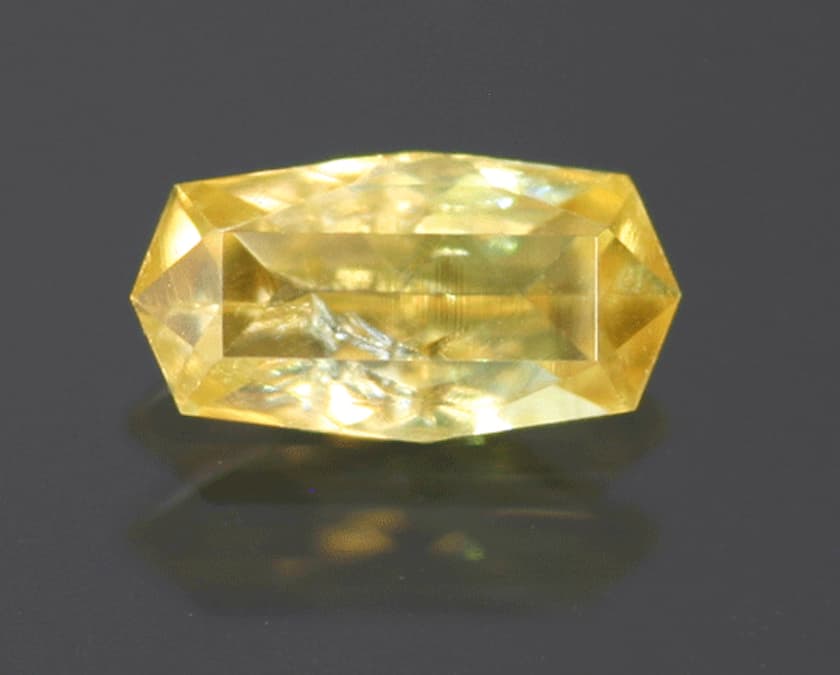Mimetite Value, Price, and Jewelry Information
Transparent mimetite crystals are extremely rare, and very few have ever been faceted. Cabochons with rich orange and yellow colors have been cut, but this material is too soft to wear as jewelry.
2 Minute Read
Transparent mimetite crystals are extremely rare, and very few have ever been faceted. Cabochons with rich orange and yellow colors have been cut, but this material is too soft to wear as jewelry.
Start an IGS Membership today
for full access to our price guide (updated monthly).Mimetite Value
Comments
Mimetite belongs to the apatite mineral group and occurs in many locations around the world. However, to date, only Namibia and China have produced very limited quantities of facetable material. With a hardness range of just 3.5 to 4, any cut mimetites are usually reserved for display in gem collections.
Mimetite also forms mineral series with both pyromorphite and vanadinite as the arsenic (As) end member.
Identifying Characteristics
With over-the-limit (OTL) refractive indices of 2.128 and 2.147, a very high specific gravity (SG) of 7.24, and piezoelectric properties, mimetite can usually be readily distinguished from more commonly encountered gemstones. However, it shares some of these characteristics as well as color ranges with a few other rarely faceted gemstones: cassiterite, vanadinite, and wulfenite.
Cassiterite and vanadinite aren't piezoelectric and typically have lower SG than mimetite. However, mimetites may have lower SG values if calcium (Ca) replaces lead (Pb) in its composition. Vanadinites usually have higher refractive indices (RIs) than mimetites, while cassiterites usually have lower RIs.
Wulfenites are well-known for their rich, red colors, but some may have yellow, orange, or brown colors. They also have piezoelectric properties and SG values close to mimetites but typically higher RIs.
All these gems are rare, but you're more likely to encounter faceted cassiterites and wulfenites than faceted mimetites and less likely to encounter faceted vanadinites. They all have distinctive hardness values, but conducting scratch tests on finished gems, especially ones so rare, isn't recommended.
Mimetites also have colors and properties that overlap or approximate those of pyromorphites. Distinguishing them may require advanced chemical analysis.
Synthetics
Scientists have synthesized mimetites for a variety of purposes, including research into the removal of arsenic from contaminated sites. However, there's no known jewelry use for this lab-created material.
Enhancements
No known gemstone treatments or enhancements.
Sources
Tsumeb, Namibia has produced fine, yellow, transparent crystals, up to 1 inch long. Most of the limited facetable material available comes from here.
More recently, Guangdong Province, China has also yielded some facetable material.
Chihuahua and Mapimi, Durango, Mexico produce fine globular masses in orange and yellow.
An opaque, banded variety of mimetite, possibly from Bolivia, has recently emerged as a lapidary material that resembles schalenblendesphalerite and "wood tin" cassiterite.
Other notable sources include the following locations:
- United Kingdom: Cornwall and Cumberland, England (a variety called campylite); Scotland.
- United States: Pennsylvania, southwestern United States (many localities).
- Australia; Czech Republic; France; Germany; Iran; Russia; Slovakia; Sweden; Thailand.
Stone Sizes
Gem cutters have made unusual, interesting cabochons up to an inch or two in length from globular Mexican mimetites.
Most transparent crystals, particularly from Tsumeb, are extremely rare and are usually preserved as mineral specimens rather than cut. However, small broken crystals have been cut, yielding some stones up to a few carats in weight, to a maximum of 5-7 carats.
Care
You're more likely to find mimetites, if at all, in mineral collections than jewelry collections. Their low hardness makes them very susceptible to scratching, so reserve any mimetite jewelry for occasional wear and use protective settings.
Mimetites contain arsenic and lead, both highly toxic. While this shouldn't pose a problem for wear or display, faceters should take precautions against inhaling or ingesting particles, protect their eyes, wash their hands, and clean their workspace after cutting mimetites. They should wear protective masks and, ideally, use a glovebox during cutting, polishing, and cleaning.
For more safety recommendations, consult our articles on lapidary safety tips and handling toxic gems.
Clean mimetites only with a soft brush, mild detergent, and warm water. For more care recommendations, consult our gemstone jewelry cleaning guide.
Joel E. Arem, Ph.D., FGA
Dr. Joel E. Arem has more than 60 years of experience in the world of gems and minerals. After obtaining his Ph.D. in Mineralogy from Harvard University, he has published numerous books that are still among the most widely used references and guidebooks on crystals, gems and minerals in the world.
Co-founder and President of numerous organizations, Dr. Arem has enjoyed a lifelong career in mineralogy and gemology. He has been a Smithsonian scientist and Curator, a consultant to many well-known companies and institutions, and a prolific author and speaker. Although his main activities have been as a gem cutter and dealer, his focus has always been education.
International Gem Society
Related Articles
Jet Value, Price, and Jewelry Information
Quartz Value, Price, and Jewelry Information
Opal Stones and Gems: Value, Price, and Jewelry Information
Chabazite Value, Price, and Jewelry Information
Never Stop Learning
When you join the IGS community, you get trusted diamond & gemstone information when you need it.
Get Gemology Insights
Get started with the International Gem Society’s free guide to gemstone identification. Join our weekly newsletter & get a free copy of the Gem ID Checklist!
